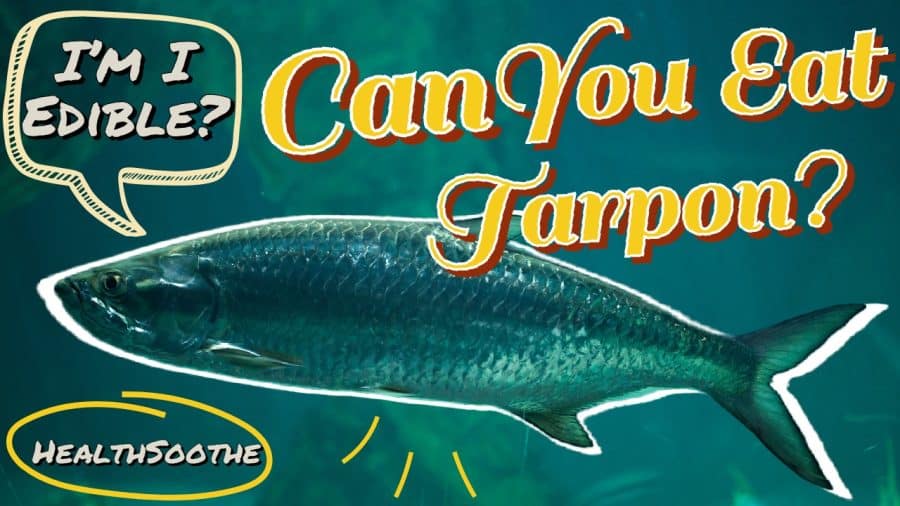Tarpon, also known as Silver King, Sabalo, and Silver Sides, is one of the most iconic fish species in the world, highly sought-after by anglers for its impressive size and acrobatic jumps.
Quick Facts About Tarpon
But what about its taste? Can you eat tarpon? This is a question that has sparked lots of debates among fishermen and seafood lovers alike.
In this blog post, we will delve deep into the topic of tarpon as food and answer all your burning questions about this remarkable fish. So sit tight and get ready to discover whether or not you should add tarpon to your menu before making your final decision!
Can You Eat Tarpon?
If you're a fan of fishing, chances are you've heard of tarpon. These silver-scaled creatures are known for their impressive size and fighting ability when hooked. But the question remains - can you eat tarpon?
The answer is yes, but it's not necessarily recommended. Tarpon have a notoriously strong gamey flavour and pungent smell that isn't enjoyed by everyone, and they also have lots of tiny, hard-to-remove bones. In fact, many anglers choose to release their catch back into the water rather than try to cook it up because the taste isn't worth the time and stress.
Although, there are some anglers who are hell-bent on eating the first fish they were able to catch even if it's a tarpon. If your first fish happens to be a tarpon, you can be rest assured that it's quite edible, but be prepared for a long process of preparing the fish and even after all that hard work, the taste might still be disappointing.
What Does Tarpon Taste Like?
Now that we've answered your question on whether you can eat tarpon or not, let's move on to discuss other questions like what does it taste like. As you've already known, the taste of a tarpon isn't something worth your sacrifice.
If you're curious about the taste of tarpon, then you're not alone. Many people wonder what this fish tastes like since it's popular among anglers but rarely found on restaurant menus.
Generally speaking, tarpon has a rich, gamey taste that some described as similar to that of other bonefish like trout but with a slightly sweeter taste. While others say that the fish has a pungent smell and weird taste
While tarpon may seem like a challenging fish to catch, prepare, and cook, I think it actually offers a unique dining experience that no other fish can.
The meat of tarpon does have a distinct fishy taste with many bones, which can make it unpleasant to eat. However, with the right ingredients and cooking technique, you can make the fish taste delicious and the entire meal a delightful experience.
By using special ingredients and following specific cooking methods, you can enhance the flavour of tarpon, making it more enjoyable for you to eat. The key is to balance the flavours and remove the bones carefully, so you can savour the delicious taste without any inconvenience.
So, don't be discouraged by the initial challenges faced when preparing tarpon. With the right approach, you can create a wonderful meal that will surely leave you satisfied and excited to try it again.
Can You Eat Tarpon Raw?
Raw tarpon consumption may pose serious health risks as the fish may contain parasites and bacteria that can cause foodborne illnesses like Vibrio vulnificus.
Consuming undercooked or raw tarpon meat can also lead to ciguatera poisoning, which affects the central nervous system and causes symptoms like nausea, vomiting, and numbness.
Moreover, eating raw tarpon meat can be unpleasant due to its texture. Tarpon has tough flesh with numerous tiny bones making it difficult to eat raw.
But if you decide to eat tarpon raw, it is best to catch them fresh from clean saltwater as the saltwater naturally helps get rid of parasites and bacteria on the skin of the fish. This makes it a bit safer to eat raw.
If you want to make sure any residual parasites are eliminated, you can also freeze the tarpon before eating it. Freezing it for at least a day will help get rid of those parasites.
So technically, freezing the tarpon is the safest way to eat it raw.
Is It Safe to Eat Tarpon?
Yes, It is absolutely safe to eat tarpon even with the bones when prepared properly and consumed in moderation. However, it is essential to handle and cook the fish with care.
There are actually various safe means to eat tarpon but the safest method is to cook thoroughly in a temperature of about 145°F.
Cooking this fish thoroughly will eliminate any residual parasite or bacteria present in the fish that may spread airborne illnesses throughout the body, it may also kill some of the fish’s pungent smell and make it more enjoyable, allowing you to have a pleasant dining experience.
It's important to catch a tarpon fresh from saltwater if you want to eat it, whether raw or cooked. Why? Well, saltwater has some special properties that can help get rid of harmful germs present in the body of the fish.
The good news is that the tarpon is totally safe to eat, just like any other yummy fish such as trout or salmon. So if you're planning to eat tarpon, make sure you find it fresh from saltwater to ensure it's safe for you to enjoy.
How To Cook Tarpon
When it comes to cooking tarpon, there are many delicious ways to prepare this fish. Since tarpon has a strong flavour, it's best to combine it with other strong-tasting ingredients or use cooking methods that help to reduce or hide the gamey taste.
To start, the first step is to remove the bones from the tarpon. This may seem a little bit challenging because there are many bones in the fish. The tarpon's skin is also oily and not good to eat, so it needs to be taken off. Also, there is a layer of fat that you'll want to remove as well.
Once you have prepared the tarpon by deboning it and cleaning it thoroughly, you can either grill, bake or fry the tarpon.
Grilling is a popular method of cooking tarpon as it gives a smoky flavour to the meat. To grill tarpon, season with your favourite spices and herbs before placing on the grill. Cook for about 5-6 minutes per side until fully cooked.
Baking is another option for those who prefer oven-cooked meals. Preheat your oven to 375°F and place seasoned tarpon fillets in a baking dish. Bake for about 15-20 minutes until fully cooked through.
Frying is also an option if you want crispy skin on your fish. Coat seasoned fillets in flour or breadcrumbs before frying them in hot oil until golden brown.
Whether grilled, baked or fried - properly seasoning tarpon will make all the difference when preparing this delicious fish!
Why Is It Not Legal To Take Tarpon Out Of The Water?
Many fishermen wonder why it is illegal to take tarpon out of the water if you don’t have a special permit to harvest them from the government. Well, this law was put in place to protect the species from overfishing and exploitation.
Tarpons are considered game fish in many states, which means they must be caught and released. It's illegal to harvest or possess these fish without the proper permits or else, you can get expensive fines or long jail terms. If you catch a tarpon while fishing in waters, it's best to release the fish back into the water unharmed.
But why is it considered illegal to take tarpon out of the waters? Well, it is considered illegal for a variety of reasons;
1. Tarpon are slow-growing fish that have a low reproductive rate, making them vulnerable to population decline. By keeping them in the water, it reduces stress on the fish and increases their chances of survival upon release.
2. Tarpon plays an important role in the ecosystem as a gamefish and as a food source for larger predators such as sharks. Removing too many from the water can disrupt this delicate balance and harm other species in the area, thereby damaging the ecosystem.
3. Tarpon also have a sensitive physiology that makes them susceptible to injury or death if mishandled. When tarpons are taken out of the water, they undergo physiological stress due to oxygen deprivation. This can cause damage to their internal organs and lead to death shortly after being released back into the water.
Why Are Tarpon Protected?
Tarpon are protected for several reasons. These fish have a significant impact on the ecosystem, as they serve as both predator and prey in their habitats. They also play an important role in recreational fishing, drawing many anglers to their waters each year.
Furthermore, tarpon can live for up to 50 years and take a long time to reach maturity, making them vulnerable to overfishing. Their populations have declined in some areas due to habitat loss and degradation, pollution, and commercial fishing practices.
In response to these threats, many states have implemented regulations that protect tarpon by limiting harvests or prohibiting certain types of fishing gear. For example, in Florida it is illegal to harvest or possess tarpon unless you have a special permit from the state.
These measures aim to ensure the continued health of tarpon populations and preserve this iconic fish for future generations to come. By protecting these magnificent creatures now we help guarantee that they will continue playing vital roles within our ecosystems while maintaining sustainable fisheries in the future!
Final Verdict
While it is technically possible to eat tarpon, many people who love seafood don't find its taste appealing enough to go through the hassle of catching one and removing its bones. Most folks consider tarpon as a game fish to catch for sport rather than as a meal.
If you happen to catch a tarpon, it's your decision whether to bring it home for eating or release it back into the water. But if you're really craving fish and are hell-bent on eating what you catch, it might be a better idea to look for other appealing fish that taste much better.
In the long run, the choice of whether to eat tarpon or appreciate them as magnificent creatures of the sea by catching and releasing them back into the water lies in the hands of each one of us.

My name is Iyanu Kolawole, I’m a professional content writer and web developer. I have always been passionate about writing and developing my coding skills. I started my career as a content writer and have written for several companies and brands. I am also a skilled web developer and have built several websites for businesses and individuals.I am a hardworking individual who is always looking to improve my skills. I am constantly striving to learn new things and to be the best at what I do. I am also a very friendly person and enjoy working with others.
The content is intended to augment, not replace, information provided by your clinician. It is not intended nor implied to be a substitute for professional medical advice. Reading this information does not create or replace a doctor-patient relationship or consultation. If required, please contact your doctor or other health care provider to assist you to interpret any of this information, or in applying the information to your individual needs.




